HEALTH AND WELLBEING
SDG GOOD HEALTH AND WELLBEING

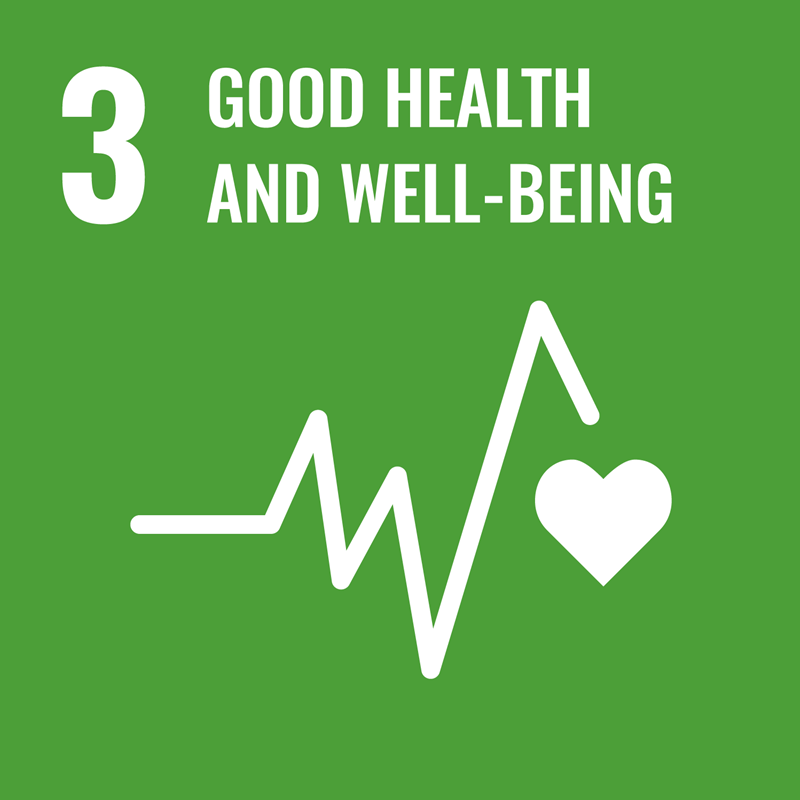
Theme definition
Health and Wellbeing encompasses both physical and mental health.
This is impacted by factors, including hereditary, individual lifestyles, social and community networks and living and working conditions.
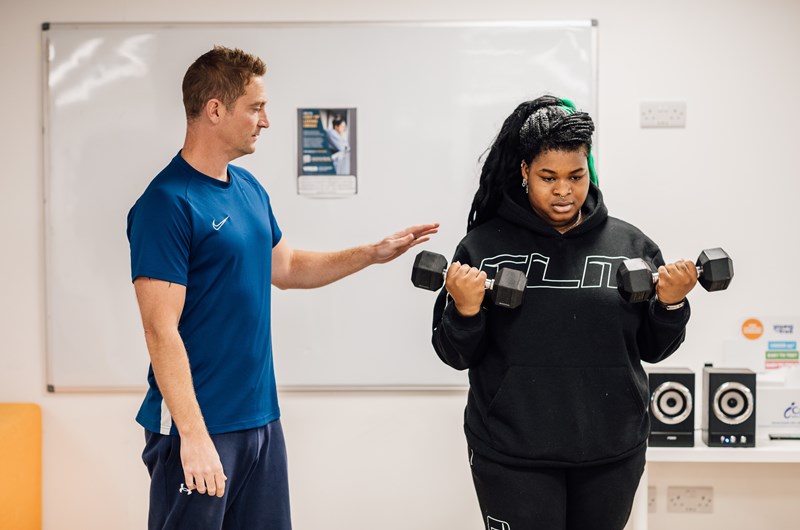
Overview
The life expectancy of Milton Keynes residents is similar overall to the average in England.
A higher proportion of adults are classified as obese (29%) compared to England overall (25.2%) and this trend is continuing.
Those who have highest deprivation, as measured by the Indices of Multiple Deprivation, are more likely to die younger from specific health conditions, and to experience lifestyles which are less supportive of good health. [1]
Young people are struggling with their mental health, especially those from poorer communities and the COVID-19 Pandemic has exacerbated this.
When asked in surveys to assess aspects of their own wellbeing, residents of Milton Keynes gave similar average scores as for England as a whole and indicated that the COVID-19 Pandemic had reduced their feelings of wellbeing.
During the COVID-19 Pandemic, the death rate from COVID-19 was slightly lower than the average for England.
Milton Keynes public health team, charities and other not-for-profit organisations are promoting and facilitating improved health and wellbeing to reduce health disparities and help employers who want to support the health and wellbeing of their staff.
Child health indicators
The percentage of children with a low birth weight has almost halved from 2013 to 2021 in Milton Keynes, but at 3.6% it is still above the average of 2.9% for England. (Table 14)
19.8% of children in Milton Keynes are classified as obese at age 10-11. This has increased by 1% from 2013 but is below the average for England. (Table 14)
The percentage of children aged 5 to 16 taking less than the recommended 30 minutes of daily exercise has increased from 32% in 2017-18 to 38% 2020/21.
Children from more deprived neighbourhoods are less likely to be undertaking 30 mins of physical activity a day compared with those from the least deprived neighbourhoods. (Sports England Active Lives Survey.)
Local public health experts have commented that lower levels of physical activity from childhood onwards contributes to the increased health risks of many life-limiting diseases that are a cause of early death in Milton Keynes.
Affordability, knowledge of what's available as well as anxiety and worry about trying something new, are some of the barriers to participation of young people in Milton Keynes in physical activities. (MK Movers, Survey of 200 young people in Milton Keynes, 2022)
(MK Movers Network is a collaboration of physical activity providers in Milton Keynes).
Ongoing funding, promotion through schools and community groups, and the opportunity for social interaction all help to increase long-term participation. (Leapwithus.org)
(LEAP is a not-for-profit organisation serving Milton Keynes and Buckinghamshire).

Health gaps
There is a life expectancy gap between those who are most and least deprived as measured by the Indices of Multiple Deprivation.
In Milton Keynes men living in the 20% most deprived neighbourhoods are likely to live 7.6 fewer years than men from the 20% least deprived neighbourhoods.
Women living in the 20% most deprived neighbourhoods are likely to live 5.6 fewer years than women from the 20% least deprived neighbourhoods. [2]
In the more deprived neighbourhoods, there are higher rates of death from circulatory diseases, cancer, and respiratory diseases. Among women in more deprived neighbourhoods, there are also higher rates of death caused by cancer and mental health issues.
This is a similar pattern for other places in the Bedfordshire, Luton, and Milton Keynes Commissioning Group. [3]
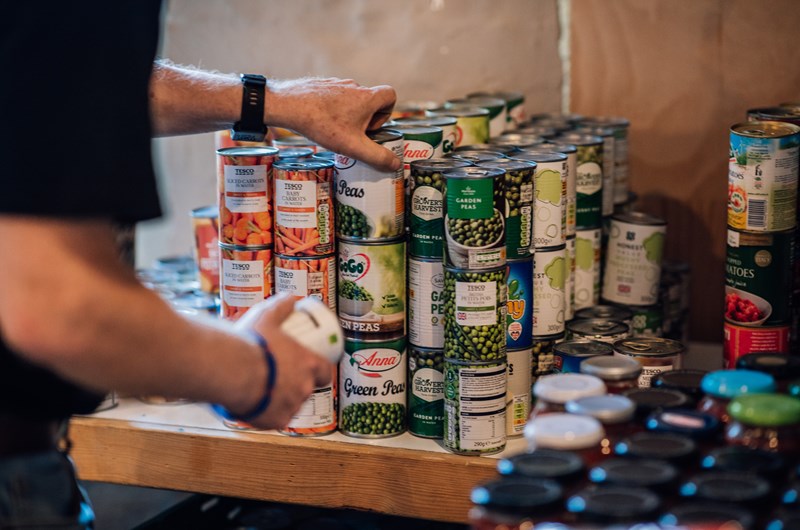
Research from Healthwatch Milton Keynes found that lower income groups had fewer opportunities to lead healthy lives, experienced transport difficulties in accessing health services, had difficulty getting time off work for medical appointments, and had less access to healthy food and dental care. [4]
29% of adults in Milton Keynes are classified as obese, compared with 25% for England, and the percentage has grown from 25% in 2015.
Obesity is associated with reduced life expectancy and a range of health conditions including Type 2 diabetes, cardiovascular disease, liver and respiratory disease and cancer.
Physical activity can contribute to reducing obesity and its associated harms. However, those living in the most deprived neighbourhoods in Milton Keynes are 10% less likely to be physically active than those in the least deprived.
The percentage of those from the poorest households not taking 150 minutes physical activity a week has increased by 2% since 2015, while the percentage not taking this amount of activity for the wealthiest neighbourhoods has decreased by 1%. (Sports England Active Lives Survey. Table 18)
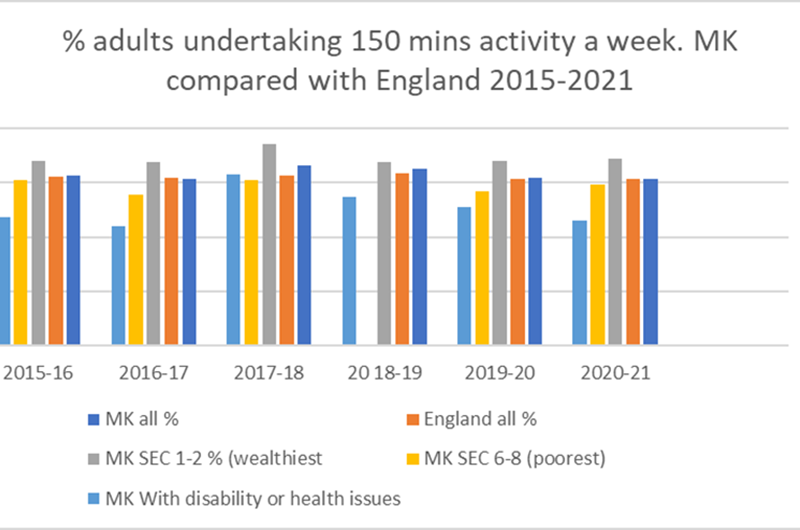
To help increase participation in physical activity among more deprived neighbourhoods, walking groups have been set up over 2022.
There are now 850 people, mainly women who regularly participate and seven leaders have been identified to champion community activity.
Barriers to participation included self-consciousness, low self-esteem, anxiety, concerns around leaving the home and lack of social confidence.
Opportunity for social interaction was a driver in getting and keeping people involved. (Leap.org)
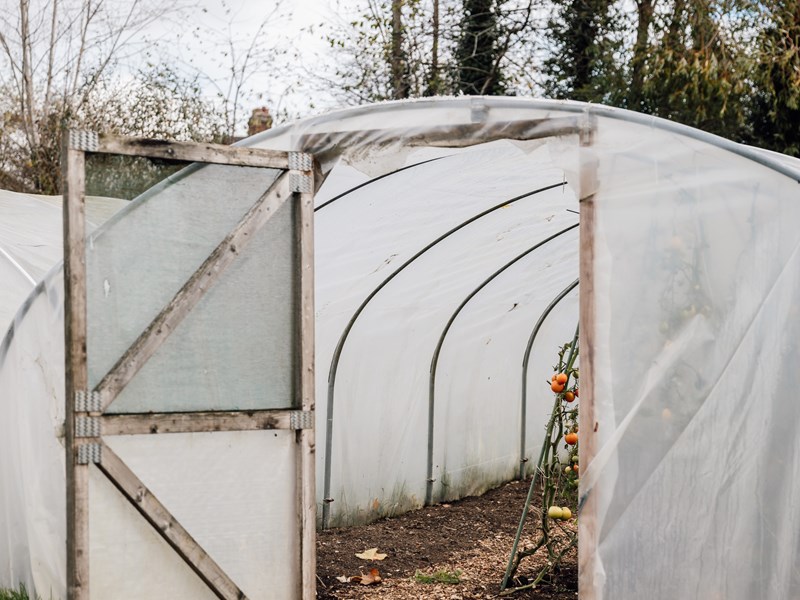
Health in the workplace
To improve the health of those in work, Milton Keynes City Council is promoting ‘Healthy Workplace Standards’ accreditation.
This provides a framework which supports sustainable improvements in workplace health and wellbeing.
A Public Health Workplace Health Team offers businesses a range of health and wellbeing services. Some specific employment areas where there is a concentration of shift and low paid jobs are a particular focus.

Mental Health
Many factors shape mental health and those with the strongest evidence demonstrating links to the development of mental health conditions include:
- experiences of poverty
- problem gambling
- adverse childhood experiences including trauma.
- unemployment
- debt and financial insecurity
- drug and alcohol misuse
- involvement in the criminal justice system (both as a victim or as an offender)
- homelessness
- loneliness, which can be exacerbated by isolating jobs
- relationship breakdown
- violence, including sexual violence.
- discrimination, including racism and homophobia.
(Public Mental Health, Bedfordshire, Luton, and Milton Keynes Clinical Commissioning Group BLMK)
Assessing differences in the prevalence of mental illness between social groups is challenging and complex.
However, national data suggests that demand for mental health services is higher among more deprived communities. [5]
Those in receipt of government income benefits have experienced greater impacts on their mental health from the COVID-19 Pandemic according to national research. [6]
This is endorsed by feedback from local charities that support disadvantaged communities who report their clients’ mental health has worsened because of struggles with low and insecure incomes, debt, and lack of food, exacerbated by the COVID-19 Pandemic and now the Cost-of-Living Crisis.
The rate of hospital admissions in Milton Keynes for self-harm has fallen to 116.9 per 100,000 of the population in 2021, from 130.9 in 2013. (See Table 20).
Table 20:
Emergency hospital admissions for intentional self harm per 100,000 of the population. [7]
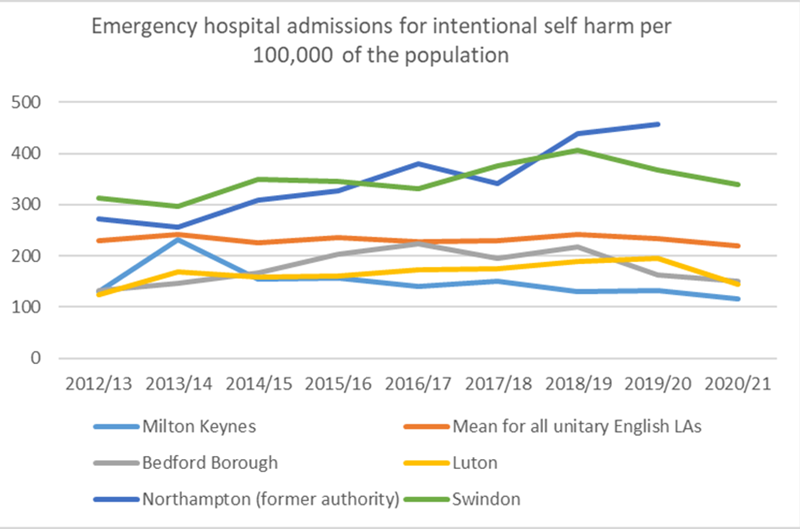
Among working adults nationally there is a correlation between suicide rate and levels of deprivation. [8]
There is an NHS target to reduce the rate of suicide nationally by 10% between 2015 and 2020.
In Milton Keynes the rate increased from 8.5 per 100,000 of the population in 2013-15 to 9.4 per 100,000 of the population in 2018-20.
The suicide rate in Milton Keynes is substantially lower than the mean rate for other English Unitary Authorities which is 11.1. (See Table 21)
Table 21:
Suicide rate per 100,000 of the population – those age 10 upwards, 3-year tranches [8]
|
3 year period |
Milton Keynes |
Mean for All English unitary authorities |
| 2013 - 15 | 8.5 | 10.9 |
| 2014 - 16 | 7.1 | 10.7 |
| 2015 - 17 | 7.6 | 10.3 |
| 2016 - 18 | 7.4 | 10.5 |
| 2017 - 19 | 8.9 | 10.9 |
| 2018 - 20 | 9.4 | 11.1 |
There is a Suicide Prevention Action Plan developed by the Bedfordshire, Luton, and Milton Keynes Clinical Commissioning Group (BLMK), in line with government requirements.
The plan is cross sectoral and multi-agency and includes crisis support, community-based and workplace activities targeted at high-risk groups and those who interact with them. The plan will be refreshed in 2023.
The local charity, Arts for Health, reported it saw that COVID-19 lockdowns increased mild/moderate mental health concerns, loneliness, anxiety, and depression, especially among those already experiencing health inequalities.
Its ‘Arts on Prescription programme’ is available on a referral basis for clients with depression, stress, and anxiety.

Wellbeing
Healthwatch Milton Keynes’ research found that lower income groups have fewer opportunities to lead healthy lives.
Local charities supporting physical activity identified barriers to include low self-esteem and lack of social confidence, as well as lack of time and opportunity, especially among those working in low-paid insecure jobs and shift work.
Hospital admissions for alcohol related conditions are slightly lower than the average for English unitary authorities but have not reduced substantially since 2013.
The death rate from COVID-19, where COVID-19 was mentioned on the death certificate, was lower in MK than England.
The COVID-19 Pandemic
There were 260 deaths per 100,000 of the population from COVID-19 in Milton Keynes compared with 299 per 100,000 of the population for England.
The rate of people taking up the offer of COVID-19 vaccinations was lower in Milton Keynes compared with the England average.
Table 23:
Vaccination take up and deaths where COVID-19 on the death certificate
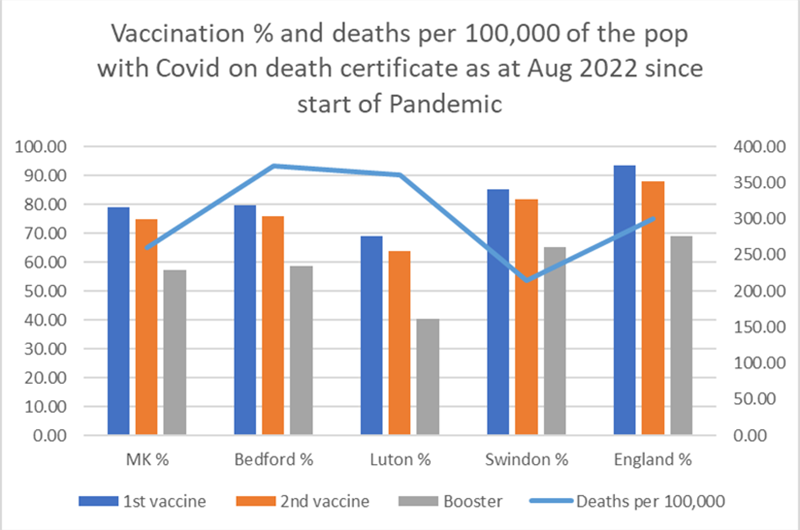
"A number of larger national employers offer gym membership and encourage flexible working to fit activity into or around the workday.
However, those in lower-paid service jobs, on shift work and working for SMEs are less likely to have access to these perks."
(Chris Gregory | Head of Strategic Relationships at Leap)
Vital Thinking
How can we facilitate wellbeing as a community, educating people for their whole lives about the importance of their physical wellbeing, and how it interacts with their mental health?
How can we empower the community to feel able to influence services provided by the local health authority to best meet their needs?

Make an enquiry
Have any questions? Feel free to get in touch with our team.
